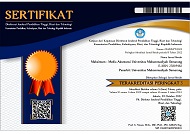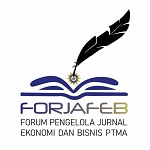Pengaruh Rasio Keuangan Terhadap Tindak Kecurangan Pelaporan Keuangan
(1) Universitas AKI Semarang
(*) Corresponding Author
Abstract
While the financial ratios issued are financial leverage, liquidity, profitability, and
capital turnover. Research has been conducted using quantitative methods with
secondary data. Secondary data comes from a list of cases in the Financial
Reporting. This research uses purposive sampling method. The total sample
obtained was 32 companies. This company classification consists of 32 companies
that do financial reporting and 32 companies that do not commit financial reporting
by collecting which companies produce the same industry and year of observation.
This study uses logistic regression statistical tools while the dependent variable is
a dummy (non-metric) variable, while the independent variable is a mixture of
metric and non-metric variables. The results show that financial leverage, liquidity
and capital turnover affect financial reporting fraud, while profitability has no
effect.
Keywoard : fraud in financial reporting, financial leverage, liquidity,
profitability, and capital turnover.
Full Text:
PDFReferences
Albrecht, W. S. and Romney, M. B. (1980), "Deterring White-Collar Crime in Banks", The Bankers Magazine 163: 60.
Blaszczynski, A. and McConaghy, N. (1994), "Criminal Offences in Gamblers Anonymous and Hospital-treated Pathological Gamblers", Journal of Gambling Studies 10, 99–127.
Clarence, Y. K. N. (2005), "White-Collar Crime is on the Rise in Malaysia, with Perpetrators Becoming More Sophisticated. Are Our Laws Sufficient Deterrents?", AsiaViews. Edition: 07/II/Feb/2005.
Crofts, P. (2002), Gambling and Criminal Behaviour: An Analysis of Local and District Court Files. Sydney: Casino Community Benefit Fund.
Goldstraw, J., Smith, R.G. and Sakurai, Y. (2005), "Gender and Serious Fraud in Australia and New Zealand", Trends and Issues in Crime and Criminal Justice 292. Australian Institute of Criminology: Canberra.
Hery (2004), “Persepsi Top Executive (Sektor Publik dan Swasta) terhadap Fungsi Internal Audit”, Journal Media Riset Akuntansi, Auditing & Informasi,Vol. 4, No. 1 April 2004:23-41.
Ikatan Akuntansi Indonesia, Standar Profesional Akuntan Publik, 2006. Jakarta: Salemba Empat
Jerry, W. L., Mark, I. H. and Jack, D. B. (2003), "A Fuzzy Neural”.
KPMG Forensic, 2004, “Fraud Survey 2004”, KPMG International, Amsterdam
Mulyadi (2002), Auditing, Edisi 6. Network for Assessing the Risk of Fraudulent Financial Reporting", Managerial. Auditing Journal 18: 657–665.
Tuanakotta, T. M. (2007). Akuntansi forensik dan audit investigatif. Jakarta: Fakultas Ekonomi Universitas Indonesia.
Article Metrics
Abstract view : 790 timesPDF - 6 times
DOI: https://doi.org/10.26714/mki.10.1.2020.41-46
Refbacks
- There are currently no refbacks.
-----------------------------------------------------------------------------------------------------------------------------------------------------------------------------------
 | MAKSIMUM: Media Akuntansi Universitas Muhammadiyah Semarang |
![]()
Maksimum: Media Akuntansi Universitas Muhammadiyah Semarang is licensed under a Creative Commons Attribution Attribution-NonCommercial-NoDerivatives 4.0 International License.

















